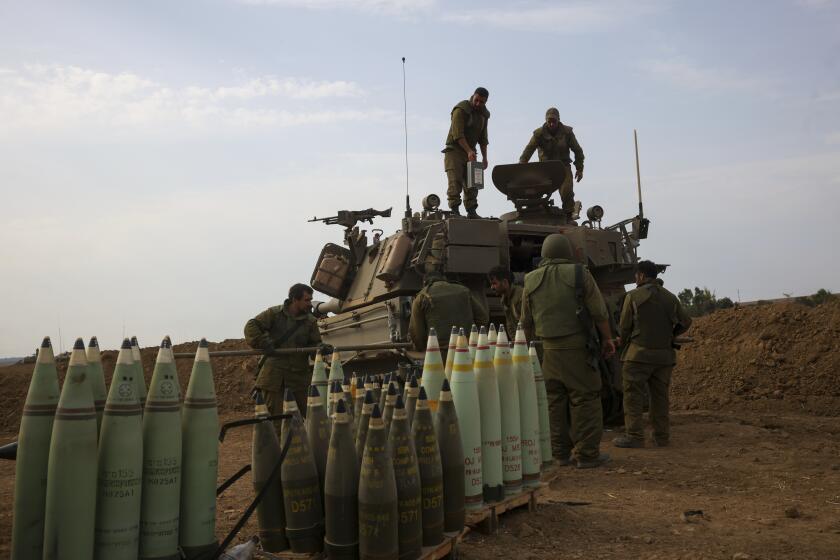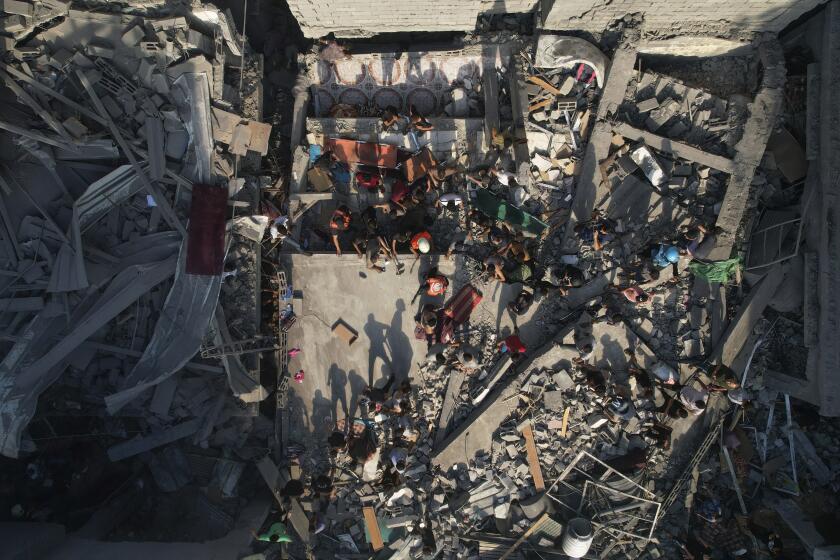Gaza hospitals are inundated with patients and desperately low on supplies as invasion looms
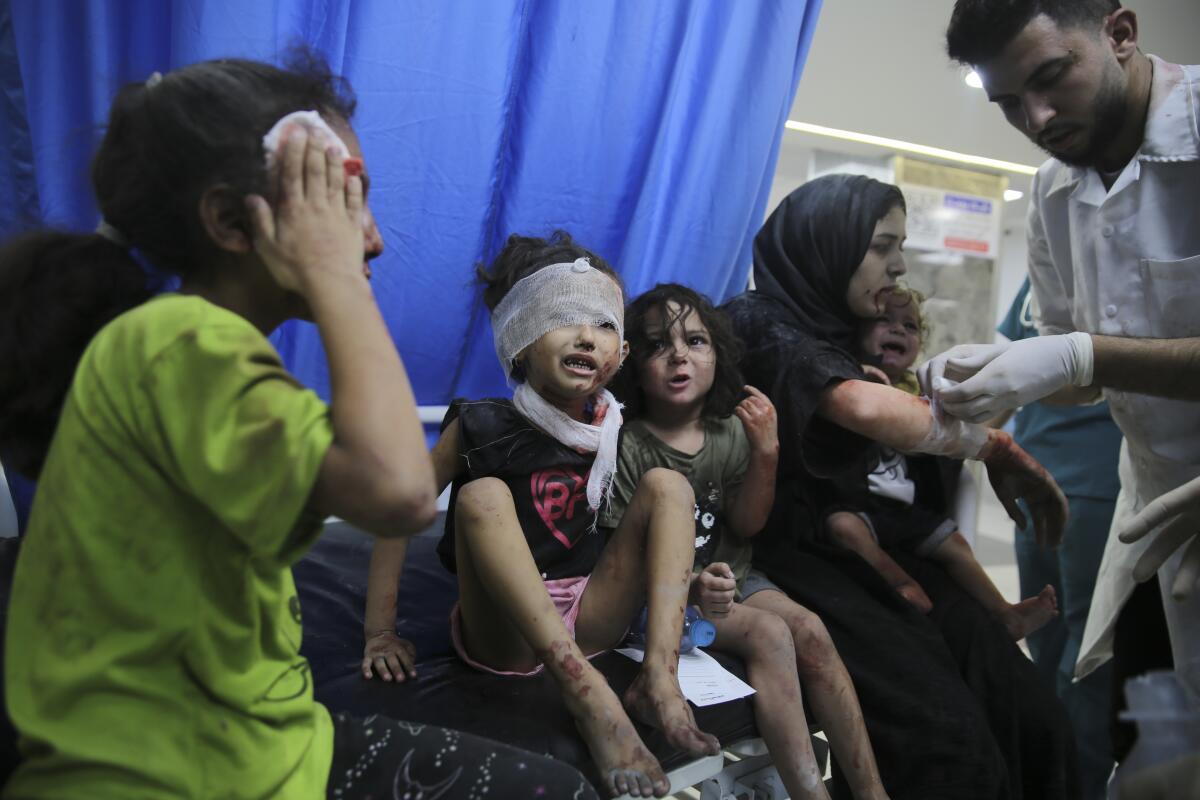
- Share via
KHAN YUNIS, Gaza Strip — Medics in the Gaza Strip warned Sunday that thousands could die as hospitals packed with wounded people ran desperately low on fuel and basic supplies. Palestinians in the besieged coastal enclave struggled to find food, water and safety ahead of an expected Israeli ground offensive in the war sparked by Hamas’ grisly cross-border rampage last weekend.
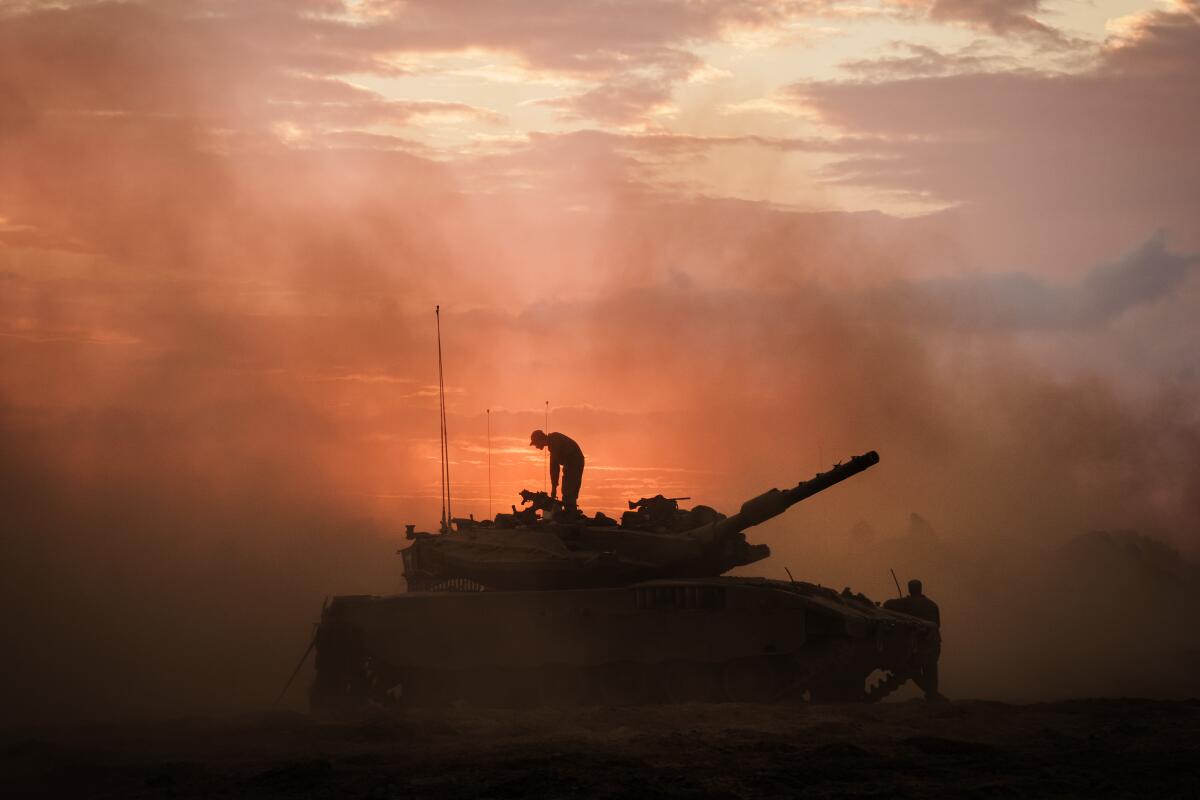
Israeli forces, supported by a growing deployment of U.S. warships in the region, positioned themselves along Gaza’s border and drilled for what Israel said would be a broad campaign to dismantle the militant group. A week of blistering airstrikes have demolished entire neighborhoods but failed to stem militant rocket fire into Israel.
The Gaza Health Ministry said 2,670 Palestinians have been killed and 9,600 wounded since the fighting erupted, more than in the 2014 Gaza war, which lasted 50 days.
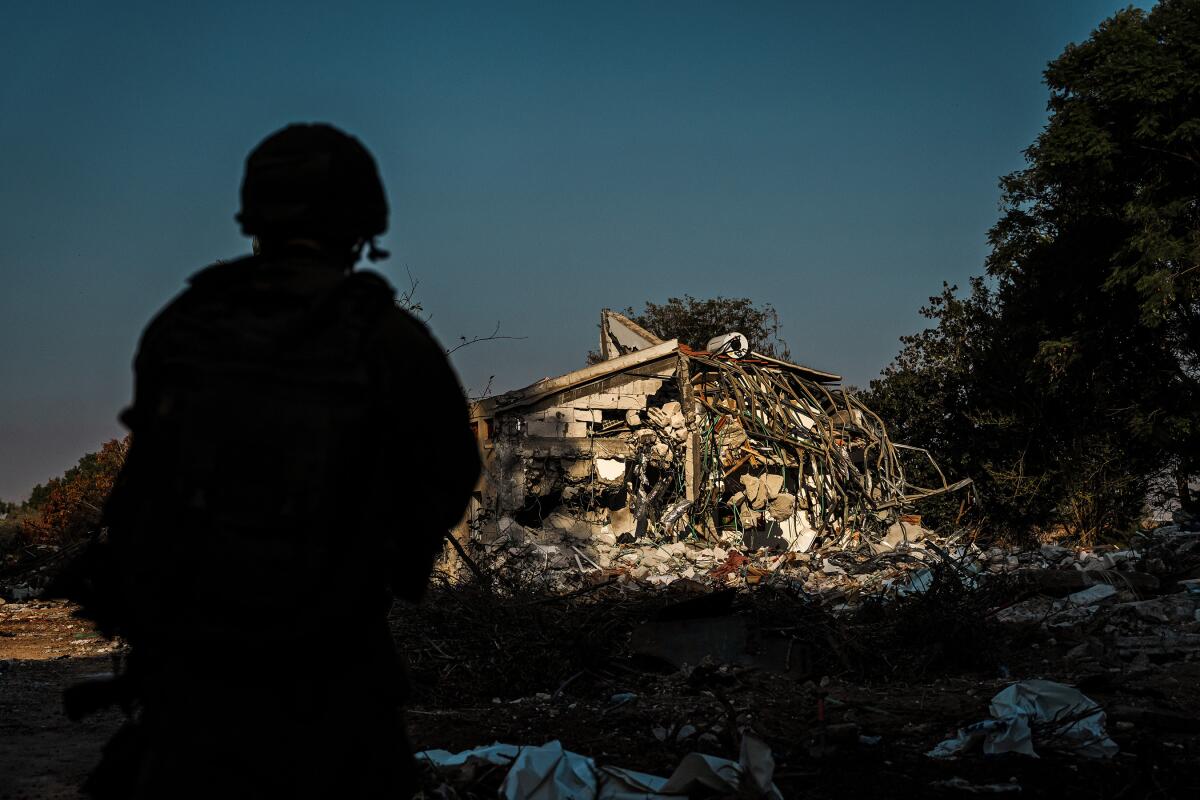
More than 1,400 Israelis have been killed, the vast majority of them civilians slaughtered randomly in Hamas’ Oct. 7 assault on kibbutzes, towns and music festival-goers. At least 155 others, including children, were captured by Hamas and taken into Gaza. This is the deadliest of five wars in Gaza and also the deadliest for Israel since the 1973 Yom Kippur War with Egypt and Syria.
The U.S. State Department said Secretary of State Antony J. Blinken would return to Israel on Monday after completing a frantic six-country tour through Arab nations aimed at preventing the fighting from igniting a broader regional conflict. President Biden is also considering a trip to Israel, according to a senior administration official, though no plans have been finalized.
Fighting along Israel’s border with Lebanon, which flared up amid the latest Gaza war, intensified Sunday with Hezbollah militants firing rockets and an antitank missile, and Israel responding with airstrikes and shelling. The Israeli military also reported that shooting broke out at one of its border posts. The fighting killed at least one person on the Israeli side and wounded several on both sides of the border.
An Israeli drone fired two missiles late Sunday at a hill west of the town of Kfar Kila in southern Lebanon, the state-run National News Agency reported. There were no casualties reported in the strikes, which hit near a Lebanese army center.
The Israeli army said in a post on X, formerly Twitter, that it had hit Hezbollah targets but did not specify what they were.
Hezbollah said in a statement that it had fired rockets toward an Israeli military position in the northern border town of Shtula in retaliation for Israeli shelling that killed Reuters videographer Issam Abdallah on Friday and two Lebanese civilians on Saturday.
A spokeswoman for Hezbollah, Rana Sahili, said the increased fighting represents a “warning” and does not mean the group has decided to enter the war.
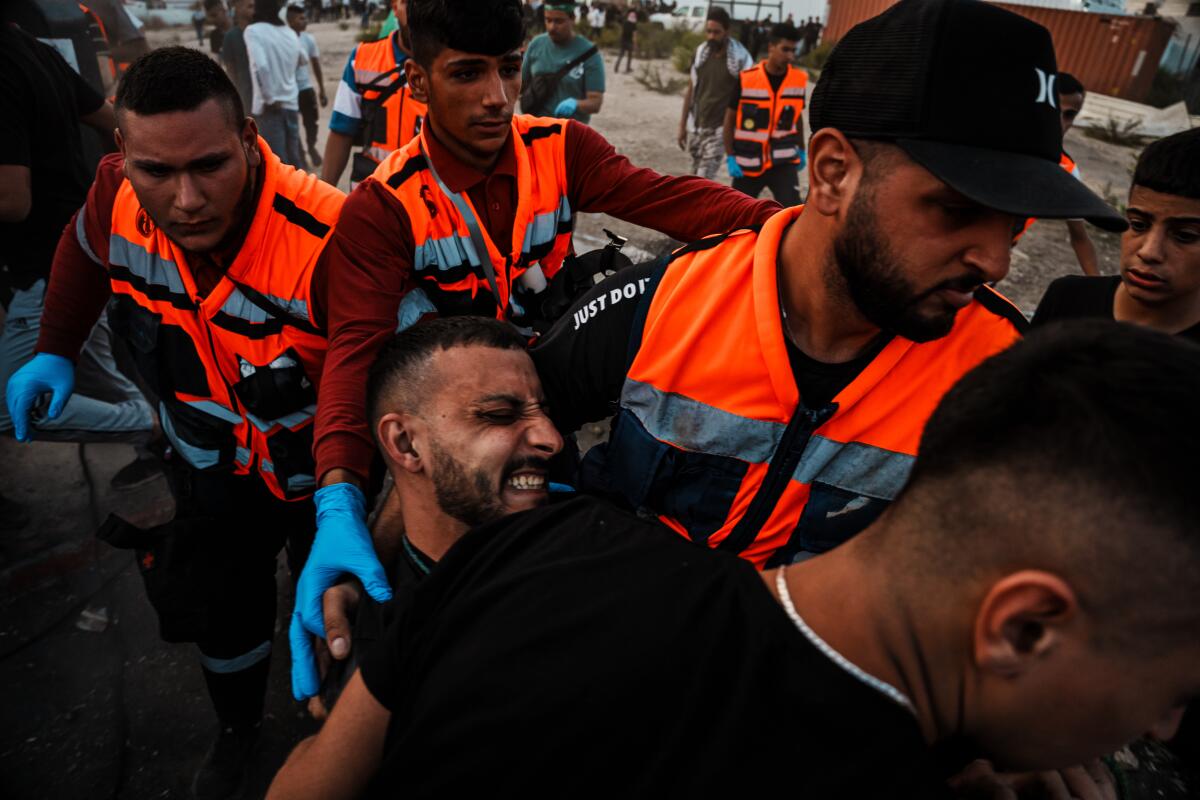
With the situation in Gaza deteriorating, the U.S. named David Satterfield, the former U.S. ambassador to Turkey with years of experience in Mideast diplomacy, to be special envoy for Middle East humanitarian issues. U.S. national security advisor Jake Sullivan said in a statement Sunday that Satterfield will focus on getting humanitarian assistance to Palestinians in Gaza.
Hospitals in Gaza are expected to run out of generator fuel within two days, endangering the lives of thousands of patients, according to the United Nations. Gaza’s sole power plant shut down for lack of fuel after Israel completely sealed off the 25-mile-long territory following the Hamas attack.
As the Jewish Sabbath fell and Muslims marked their principal prayer day, Israelis and Palestinians struggled with the terrifying new reality after the militant group Hamas’ deadly attack on Israel.
At Nasser Hospital, in the southern town of Khan Yunis, intensive care rooms were packed with wounded patients, most of them children under age 3. Hundreds of people with severe blast injuries have come to the hospital, where fuel is expected to run out by Monday, said Dr. Mohammed Qandeel, a consultant at the critical care complex.
There were 35 patients in the ICU who required ventilators and 60 more on dialysis. If fuel runs out, “it means the whole health system will be shut down,” he said. “All these patients are in danger of death if the electricity is cut off.”
Dr. Hussam Abu Safiya, the head of pediatrics at the Kamal Adwan Hospital in northern Gaza, said it did not evacuate despite Israeli orders. There were seven newborns in the ICU hooked up to ventilators, he said. “We cannot evacuate, that would mean death for them and other patients under our care.”
Shifa Hospital in Gaza City, the territory’s largest, said it would bury 100 bodies in a mass grave as an emergency measure after its morgue overflowed, with relatives unable to bury their loved ones. Tens of thousands of people seeking safety have gathered in the hospital compound.
Israel battled Hamas infiltrators for a third day and massed tens of thousands of troops near the Gaza Strip after the biggest attack in decades on Israeli soil.
Gazans faced a growing shortage of water and medical supplies due to the Israeli siege. With some bakeries closing, residents said they were unable to buy bread. Israel has also cut off water, forcing many to rely on brackish wells.
Sullivan said on CNN that Israeli officials told him they had turned the water back on in southern Gaza. Israel’s minister of energy and water, Israel Katz, said in a statement that water had been restored at one “specific point” in Gaza, but did not give further details. Aid workers in Gaza said they had not yet seen evidence that the water was flowing again.
Israel has ordered more than 1 million Palestinians — almost half the territory’s population — to move south. The military says it is trying to clear away civilians ahead of a major campaign against Hamas in the north, where it says the militants have extensive networks of tunnels, bunkers and rocket launchers.
Hamas urged people to stay in their homes, and the Israeli military released photos it said showed a Hamas roadblock preventing traffic from moving south.
Nevertheless, more than 600,000 people had evacuated the Gaza City area, said Israel’s chief military spokesman, Rear Adm. Daniel Hagari.
About 500,000 people, nearly a quarter of Gaza’s population, were taking refuge in United Nations schools and other facilities across the territory, where water supplies were dwindling, said Juliette Touma, spokesperson for the U.N.’s Palestinian refugee agency. “Gaza is running dry,” she said.
The U.N. and aid groups say the mass exodus within Gaza, along with Israel’s complete siege, will cause untold human suffering. The World Health Organization said the evacuation “could be tantamount to a death sentence” for the more than 2,000 patients in northern hospitals.
Palestinian Americans with Gaza connections struggle with feelings of helplessness over violence after Hamas’ attack and Israel’s retaliation.
The military said Sunday that it would not target a specific route south for several hours, again urging Palestinians to leave the north en masse. The military offered two corridors and a longer window the day before. It says hundreds of thousands have already fled south.
The U.N. agency for Palestinian refugees says an estimated 1 million people have been displaced in Gaza in a week.
Hamas rocket attacks continued Sunday, prompting a broader evacuation from the southern Israeli city of Sderot. The city of about 34,000 people sits about a mile from Gaza and has been a frequent rocket target. “The kids are traumatized, they can’t sleep at night,” Yossi Edri told Channel 13 before boarding a bus.
The military said Sunday that an airstrike in southern Gaza had killed a Hamas commander blamed for the killings at Nirim, one of several communities Hamas had attacked in southern Israel. Israel said it struck more than 100 military targets overnight, including command centers and rocket launchers.
Israel has called up about 360,000 military reservists and massed troops and tanks along the border with Gaza. Israelis living near the Gaza border, including residents of Sderot, continued to be evacuated. Militants in Gaza have fired more than 5,500 rockets since the hostilities erupted, many reaching reaching deep into Israel, as Israeli warplanes pound Gaza.
Israeli officials said the goal of their Gaza offensive was to destroy Hamas.
“If Hamas thought we would fall apart, then no: We will tear Hamas apart,” Prime Minister Benjamin Netanyahu said at the start of Israel’s Cabinet meeting Sunday.
Israeli officials gave no timetable for a ground invasion.
When asked at a news briefing whether Israel would treat civilians who stay in the north as combatants, Lt. Col. Richard Hecht, another army spokesman, said: “That’s why we’ve encouraged people not involved with Hamas to move south.”
U.S. Defense Secretary Lloyd J. Austin III said late Saturday that the U.S. was moving a second carrier strike group, the USS Dwight D. Eisenhower, to the eastern Mediterranean, in a show of force meant to deter Hamas allies such as Iran and Hezbollah from seeking to widen the war.
Hamas remained defiant. In a televised speech Saturday, Ismail Haniyeh, a top official based abroad, said that “all the massacres” will not break the Palestinian people.
The U.S. has been trying to broker a deal to reopen Egypt’s Rafah crossing with Gaza to allow Americans and other foreigners to leave and humanitarian aid massed on the Egyptian side to be brought in. The crossing, which was closed because of airstrikes early in the war, has yet to reopen.
Israel has said the siege will be lifted only when the captives are returned.
Hundreds of relatives of those captured by Hamas gathered outside the Israeli Defense Ministry in Tel Aviv late Saturday, demanding their release.
“This is my cry out to the world: Please help bring my family, my wife and three kids,” said Avihai Brodtz of Kfar Azza.
More to Read
Sign up for Essential California
The most important California stories and recommendations in your inbox every morning.
You may occasionally receive promotional content from the Los Angeles Times.

